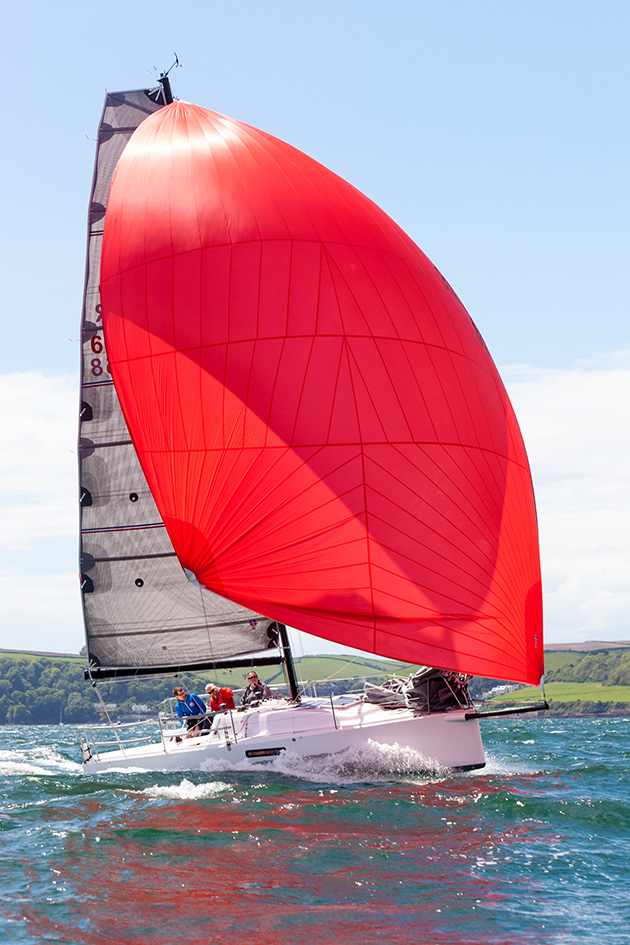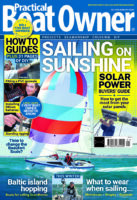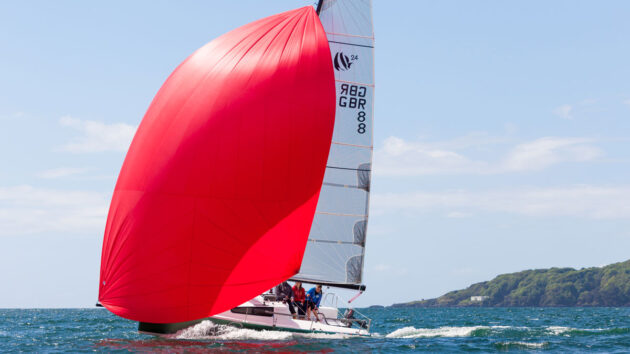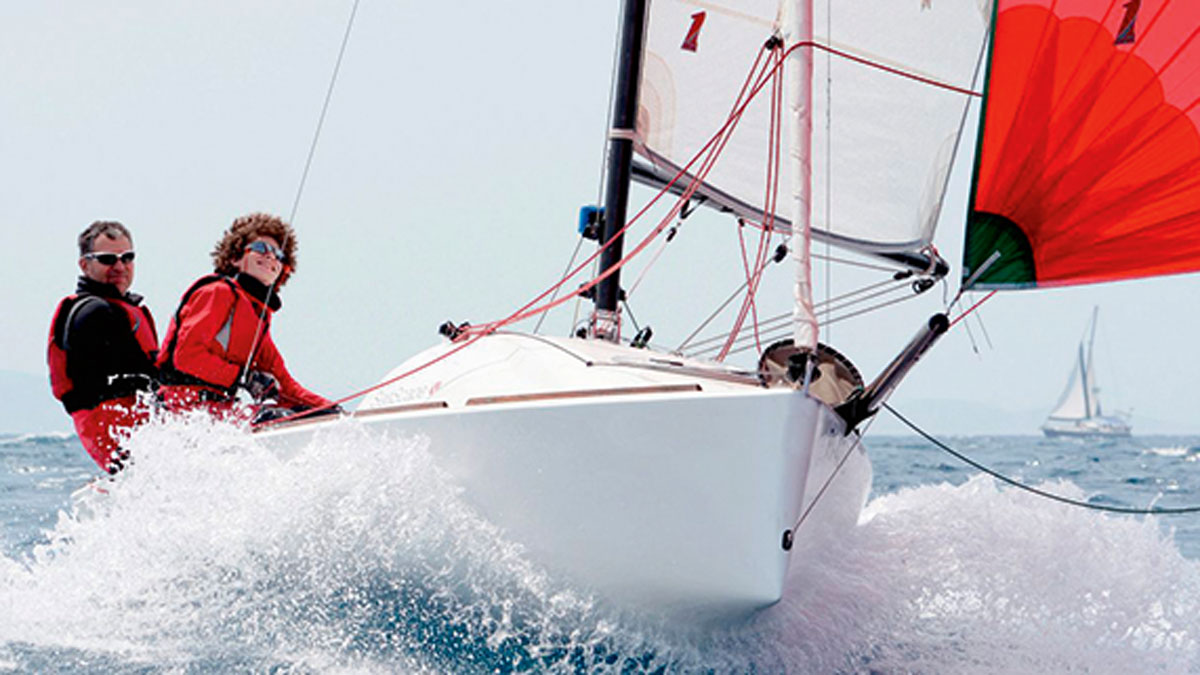Bowling effortlessly downwind at 15 knots can be fun, but what are the compromises? David Harding sails the Seascape 24 and Seascape 27 to find out
Seascape 24 vs Seascape 27: Is a planing cruiser really practical?
Seascape 24 vs Seascape 27: Is a planing cruiser really practical?
Let’s face it: fast is fun – or at least it is to most of us. Of course, there’s great pleasure to be had in pottering gently but, when you have a fistful of wind
from abaft the beam and some waves to play with, who doesn’t enjoy seeing what their boat can do?
For sailors in small, single-hulled cruising yachts, ‘what the boat can do’ has traditionally been 7 or perhaps 8 knots if your luck and judgement are in and you get surfing down a few waves.
On bigger or racier boats on a good day, you might break into double figures. Pushing any harder would lead to a risk of broaching, breaking something or simply digging a hole in the water.
The harder you push the deeper the hole, the greater the loads and the more unstable everything becomes.
That’s the way things were for a long time.

The Seascape 27 came with a lifting keel as standard. Credit: David Harding
But today, it is different, which became clear when testing a 26ft (8m) swing-keel performance cruiser in Plymouth.
I was helming a boat that was doing 14 knots downwind (and capable of a good deal more without breaking sweat). There were five of us aboard, but three could have managed.
Everything was relaxed; we were simply enjoying a downwind blast from Cawsand back towards Queen Anne’s Battery. There wasn’t a white knuckle in sight, and the boat remained light and perfectly under control the whole time (including during several gybes).
This was in a wind that peaked at around 20 knots. Oh, and the water was more-or-less flat inside the breakwater, so we’re not talking about brief moments of surfing down the front of a wave: this was full-on planing.
Our GPS tracker showed that our best average over a distance of 500m (550 yards) was 11.8 knots. That’s pretty well the same speed I clocked over the same distance at Weymouth Speed Week in a prototype experimental 11ft (3.35m) dinghy back in the ’80s, and that was hard work.
The plane truth
To those familiar with modern sportsboats – Melges 24s, J/70s et al. – this will sound pretty humdrum. They might argue that 14 knots is really nothing to get excited about.
In some ways, that’s true. We would have gone faster in more wind and, in any event, it’s not as though many of us haven’t seen speeds a good deal higher than 14 knots –even if they’re just peak surfing speeds – on a whole range of boats.
What’s remarkable, however, is that this sort of full planing performance is something you can enjoy in an easily-handled performance cruiser.
You don’t need both wind and waves to have fun any more; wind alone will do. It’s like sailing a dinghy, only easier and with less risk of falling over.
Without a doubt, the Seascape 27 I was sailing in Plymouth is among the most easily-handled boats you could wish to meet. The same goes for the Seascape 24, on which we clocked 12 knots in a little less wind earlier that afternoon.
If you have tended to associate planing keelboats with teams of muscular, professional racing sailors narrowly avoiding (or perhaps not avoiding) major wipe-outs through a combination of skill, experience and grunt – well, you’ll have been right.
On the whole, full-on racing sportsboats are demanding and unforgiving, and the bigger they get, the more grunt you need.
Seeing the current generation of Fast 40s hammering downwind is a spectacle – especially if you’re racing in close proximity to them – but some consider (with good reason) that these boats are nothing short of brutal to sail.

The Seascape 27 has good speed and pointing upwind. Credit: David Harding
The owner of the Seascape 27, who joined us for the test, previously owned a full-bore racing sportsboat and has been struck by the forgiving nature of the Seascape.
As one of our crew chirpily commented as we hummed along at 12 knots on the Seascape 24, ‘If you were in a Melges 24 now, you’d be on your side wondering, ‘What happened?’’
The message here is simple: today’s performance cruisers can be fast, fun and easy to sail. So how has this come about?
Well, it’s not all that new. Racing keelboats have been getting lighter and faster for decades.
Just think how the J/24 shook up the racing scene back in the late 1970s, leaving 35-footers in her wake, and how we’ve seen everything from the Mini Transats to the IMOCA 60s and Volvo 70s achieving downwind speeds that would have been hard to imagine only a few decades ago.
And as for speeds of the IMOCA 60s in the Vendée Globe….
Some of this performance is due to canting keels and foils, too (if you manage not to break them), but lighter, stronger structures have much to do with it.
Racing: improving the breed?
It might be argued that the needs of racing sailors and cruising sailors are different, so developments that make racing boats faster don’t necessarily help cruising folk.
Then again, there’s cruising and there’s cruising: are you talking about a boat for coast-hopping or for bluewater voyaging?
If it’s the former – and for most people, it is – then what’s been happening in racing circles will probably have more of a bearing on the sort of boat you buy.

The deep swing keel adds power upwind to the Seascape 24. Credit: David Harding
Just think Pogo, which was among the first builders to introduce the minimalist, lightweight planing cruiser.
We have seen even mainstream cruisers changing noticeably over the past decade or so because of racing’s influence.
Hulls have become beamier aft, flatter and typically chined at the sterns. Keels are deeper and of higher aspect ratio, often with bulbs at the bottom, and carbon rigs are a more popular option than ever.
Square-top or fat-head mains are a common sight and asymmetric spinnakers, set from retractable bowsprits, have almost become the norm.
With many cruising yachts, this produces no dramatic effects or at least no dramatic improvements. They just look more modern and might go a bit faster downwind.
But then you get boats like the Seascape 24 and Seascape 27 that really do redefine performance cruising.
Seascape 24
This is by no means just another sportsboat. The Seascape 24 is designed to be easy to rig, launch, trail and sail, all single-handed if necessary, and she comes with a keel that swings up inside the hull rather than lifting vertically.
Options include a cockpit tent and, as with the 18, the Seascape 24 is aimed very much at the trailer-sailer camper-cruiser market.

Launching the Seascape 24 from her trailer at Queen Anne’s Battery. Credit: David Harding
Camper-cruising on light, fast, simple boats like this is extremely popular in mainland Europe.
The Seascape 18 is widely and competitively raced over there, but many owners also trail and sail with their families and friends. Only in the UK, it seems, has the 18 been viewed as a slightly detuned sportsboat that’s designed for racing and little else.
In fact, with her fully-retractable swing keel and light, easy-to-raise carbon rig, she would be ideal for raids and would undoubtedly run rings around many of the more traditional offerings.
Inshore offshore
One factor that differentiates the Seascape 24 from most of her more extreme round-the-cans competitors is that she’s compliant with RORC Category 4, meaning she can be used for coastal passage racing if you’re so minded.
I know of one sailor who completed a 25-mile upwind/downwind race in a Seascape 24 from Plymouth in 15-20 knots of breeze, finishing not far adrift of a J/105, X 332 and Sun Fast 3200.
Not surprisingly, he didn’t quite hang on to them upwind but pulled a lot back on the downwind leg.
My introduction to the Seascape 24 was in a Wednesday evening club race in Plymouth Sound in a mixed handicap fleet.
The light and shifty breeze ranged between about 7 and 12 knots – not ideal for this boat – and we were only three-up, so a bit short of hands at the marks.

The deck layout on the Seascape 24 is neat and efficient. Credit: David Harding
We still won our class, finishing a little way behind a Mumm 36, a J/109 and an X 99 on the water.
The following day, for our test, we had a spanking 15-20 knots that let the boat off the leash.
The first point to make is that the Seascape 24 is incredibly easy to sail; taut, responsive and predictable.
She’ll fizz along at a more-than-respectable 5 to 5.5 knots upwind as long as you don’t over-sheet the mainsail. The sheet is taken to a bridle, and there’s no traveller or backstay, so you have to use the vang and resist the temptation to point too high.
Your Velocity Made Good (VMG) is better if you put the bow down a little and let the boat heel to around 20°.
The helmsman’s perch is comfortable, and there’s plenty of space in the cockpit if you’re not racing and your crew wants to stay inboard.
That’s where the Seascape 24 really scores: you can race competitively or blast around if you want to, or sail on half throttle with a family crew and still leave most boats in your wake.
That low-cg keel gives a draught of 2m (6ft 7in) and a lot of righting moment.

The Seascape 24 is RCD Category C. Credit: David Harding
Every aspect of how the boat sails and is handled has clearly been thought out.
The deck hardware is efficient and in the right place. There’s no slop in the steering, and the feedback from the twin rudders is as good as I’ve experienced on any boat with two blades.
Everything is light, precise and responsive; there was no hint of slack or play anywhere, even when we bounced over some meaningful waves off the western end of the breakwater.
I expected some thudding from the centreplate, but it was like sailing a fin-keeler. It makes a delightful change to sail a boat on which things work as they should and where no areas appear to have been overlooked.
The fact that the Seascape team are experienced short-handed offshore sailors and fully up to speed with Open Class designs really shows.
In fact, Sam Manuard, the designer, has a second place in the Transat Jacques Vabre to his credit. These guys know what they’re doing.
Our test boat had the single, 450mm-high guardwire that comes as standard and is low enough for the crew to hike efficiently.
It’s not ideal for the helmsman because you can’t get your torso outboard unless you’re not racing, in which case you can dip underneath it.
For racing, twin guardwires would be better for the helm (and are Cat 4 compliant), and they would work for the crew too, providing they’re good at unthreading themselves during tacks.
Downwind with distinction
What is there to say about the performance downwind of the Seascape 24? It was 10-12 knots all the way. During one gybe, we dropped below 10 knots only for a few seconds before heading straight back into double figures.
There’s next to no load on anything. Not once did the boat even threaten to broach. A little more wind would have made things livelier, of course, and every boat has its limits, but at no stage were we anywhere near them.
If your interest is cruising or family sailing, you might choose a smaller jib and a Code 5 asymmetric on a furler that could stay on the end of the bowsprit.
Detuning is simple: there are options for however you want to sail.

It is light, simple, airy and open plan below decks on the Seascape 24. Credit: David Harding
Accommodation on the Seascape 24
The accommodation is light, simple and totally open-plan. Buoyancy is beneath the berths at both ends, so under-bunk stowage is limited.
This is a weekender, and removable soft stowage bags will accommodate the essentials.
An interior moulding forms the bunk fronts, but that’s it: otherwise, the structure is fully accessible, and there are no superfluous mouldings or linings adding weight and taking up space.
You have comfortable sitting headroom, berths for four people to stretch out horizontally, space for a chemical toilet, a table for use in the cabin and cockpit – everything you need for the simple camper-cruising life.
Verduct on Seascape 24
The Seascape 24 is a very appealing little boat. She’s fast, enormous fun to sail and dead easy to handle. We started and finished the day with her ashore on her trailer in Queen Anne’s Battery, so I saw how simple she is to launch and recover.
The light weight is fundamental to her performance, yet construction appears reassuringly tough: hull and deck are vacuum-infused cored laminates with a higher-density core in the bottom of the hull.
Longitudinal and lateral stiffening members abound. The whole approach smacks of honesty, simplicity, intelligent design and a complete lack of pretentiousness.
As the designer says, he wanted a boat that’s fast, fun and hassle-free. There’s no doubt he has succeeded. The Seascape 24 does what she’s designed to do incredibly well.
Seascape 24 specifications
Price: From £41,350 (new)
LOA: 7.30m (24ft 0in)
LWL: 7.30m (24ft 0in)
Beam: 2.50m (8ft 2.5in)
Draught – keel up: 0.20m (0ft 7in)
– keel down: 2.00m (6ft 6in)
Displacement: 890kg (1,962lb)
Keel weight: 320kg (705lb)
Sail area: 42.0sq m (452.0sq ft)
Displacement/length ratio: 63.56
Sail area/displacement ratio: 47.4
Engine: 2-4hp outboard
RCD category: C
Designer: Sam Manuard
Builder: Seascape, Slovenia
Seascape 27
The 27 inevitably has the feel of a bigger, more serious boat than the 24 and is designed with offshore sailing in mind.
Steve, the owner, also chose a lightweight Saildrive 330 inboard (developed specifically for boats like this and about half the weight of a conventional alternative) instead of the normal 9.8hp Tohatsu outboard.

The Seascape 27 has a beam of 2.54m/8ft 4in. Credit: David Harding
Another principal difference is that the keel swings up beneath the hull, operated by a hydraulic ram instead of a worm drive (with the optional electric
upgrade on this boat).
Performance-wise, the 27 did what a bigger boat should do. She went faster, clocking into the low 6s upwind and up to 13.8 downwind.
After dropping the kite slightly early on the way back home to avoid a German frigate, we two-sail reached the last few hundred yards at 8-9 knots without trying.

The optional petrol inboard on the Seascape 27 is an 18hp Saildrive 330. Based on a Parsun outboard head, the whole assembly, including the leg, weighs a mere 50kg (110lb). Credit: David Harding
Anything less than 10 knots downwind felt positively pedestrian.
Below decks, the 27 is light, neat and frill-free in the style of the short-handed offshore race boat but perfectly practical for basic cruising if you can cope with a jetboil for cooking rather than a fully-fitted galley.
Verdict on Seascape 27
The important thing about the Seascapes is to understand the concept of the lightweight, minimalist planing performance cruiser.
These boats aren’t wild at all; in fact, they’re well on the way to being domesticated.

No frills below decks on the 27, but fine for the simple life at sea. Credit: David Harding
Strange though it may sound, the most likely alternative to a boat like this might be a sporty trimaran. The Seascapes probably have more in common with the Dragonflies and Corsairs than with most monohulls as cruising sailors know them.
Boats like the Seascapes won’t suit everyone, but they help restore my faith in the evolution of yacht design.
Seascape 27 specifications
Price: From £57,500
LOA: 7.99m (26ft 2,5in)
LWL: 7.99m (26ft 2.5in)
Beam: 2.54m (8ft 4in)
Draught – keel up: 0.95m (3ft 1in)
– keel down: 1.95m (6ft 4in)
Displacement: 1,380kg (3,042lb)
Keel weight: 610kg (1,345lb)
Sail area: 48.0sq m (516sq ft)
Displacement/length ratio: 75.97
Sail area/displacement ratio: 39.29
Engine: 9.8hp outboard or 18hp inboard
RCD category: B
Designer: Sam Manuard
Builder: Seascape, Slovenia
Seascape 18: the light fantastic trailer-sailer
Despite her racy appearance, the Seascape 18 is a versatile and well-mannered trailer-sailer – as David Harding reports
Pointer 22: the refreshingly simple trailer-sailer
Light, slim and fast, the Pointer 22 is a no-nonsense day-sailer-cum-weekender, says David Harding
Haber 620: a trailer sailer like no other
How on earth do you get full standing headroom in a trailer-sailer that really sails? David Harding meets the Haber…
J/24: Sailing one of the world’s most popular boats
The 1970s saw plenty of innovation on the USA’s north-eastern coasts. The wide-beam almost flush deck 24-footer Ragtime that Rod…
Want to read more boat test articles?

A subscription to Practical Boat Owner magazine costs around 40% less than the cover price.
Print and digital editions are available through Magazines Direct – where you can also find the latest deals.
PBO is packed with information to help you get the most from boat ownership – whether sail or power.
-
-
-
- Take your DIY skills to the next level with trusted advice on boat maintenance and repairs
- Impartial, in-depth gear reviews
- Practical cruising tips for making the most of your time afloat
-
-
Follow us on Facebook, Instagram, TikTok and Twitter








